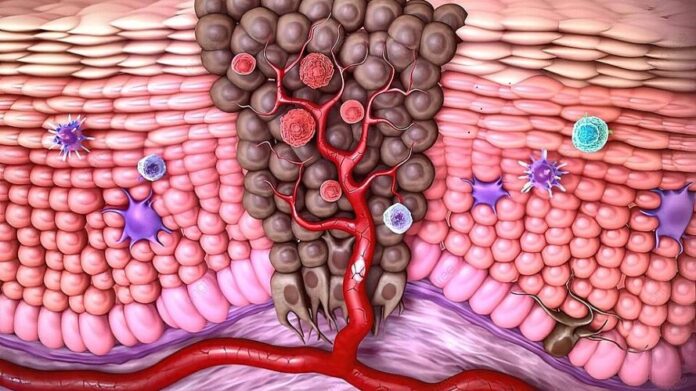Written by Dr Maljini Gunarathna M.D
As a medical doctor from Sri Lanka, I am surprised when people back home tell me that sunscreen is only for light-skinned people! This is a myth that needs changing and in this article I will tell you all the important facts about skin cancer in people of colour, using scientific evidence.
The myth about melanin
Melanin, the pigment responsible for skin colour, offers intrinsic protection against ultraviolet (UV) radiation. However, this protective mechanism does not provide absolute immunity towards skin cancer in individuals with darker skin tones.
Unfortunately, the misconception that people of colour are immune to skin cancer often leads to skin cancer in people with deeper skin tones to go undiagnosed. This delay in detection causes it to advance to more severe stages at the time of diagnosis. Timely recognition of skin cancer is paramount, since early diagnosis significantly improves outcomes.
Signs to look out for on your skin
Skin cancer in people of colour commonly appear in atypical ways. Early signs of melanoma, the most fatal form of skin cancer, show up in uncommon places such as the finger and toe nails, palms and soles, and the inner surface of the mouth and genitals.

American Academy of Dermatology Association
Risk factors for skin cancer
Prolonged or frequent UV Radiation Exposure: Despite possessing more melanin, people with darker skin are susceptible to UV radiation damage. Even if there is less or no sun burns in people of colour it doesn’t mean there is no damage on a DNA level. Specially people who work outdoors and play outdoor sports without adequate protection from the sun, tend to be at risk of developing it later in life.
Genetic Predispositions: Genetic factors play a role in its predisposition among people of colour. Understanding familial history can help in identifying those at higher risk. If you had a previous diagnosis or if a close relative had been diagnosed with skin cancer it is advised to make an appointment with your dermatologist or family doctor to discuss your risk and preventative strategies.
Prevention is better than cure
Sun Protection:
- Regular application of broad-spectrum, water-resistant sunscreen with a minimum of 30 SPF to block 97% of harmful UVA/UVB radiation for both adults and children. A thin layer can be applied to the entire body a minimum of 30 minutes prior to sun exposure and reapplied every 2 hours after excessive sweating or swimming.
- It is advised to avoid prolonged sun exposure between 11am and 3pm.
- Additionally, the use of protective clothing, sunglasses and seeking shade are essential across the spectrum of skin tones and ages.
Self-Check: Routine self-examinations are vital for detecting any abnormal skin lesions in all ages and skin tones. Furthermore, it is important to get an screening done by your primary healthcare physician or dermatologist.
The ABCDE method can be practical methods you can use when you do self-checks
ABCDEs of Melanoma:

Changing the conversation around skin cancer starts here
Building a culturally competent healthcare system: This is crucial in addressing the screening and care of skin cancers in people of colour.
- Primary care physicians should be educated on encouraging patients of colour to get routine screenings.
- Ensuring healthcare professionals are culturally competent and attuned to the unique characteristics of skin cancer in people of colour is vital. This includes understanding variations in skin manifestations and addressing potential disparities in healthcare access.
Community-centric education system: An integral part of awareness is spreading evidence-based information within diverse cultural backgrounds.
- Culturally sensitive education can debunk myths, encourage preventive measures, and promote regular skin screenings within specific cultural contexts. Tailoring awareness campaigns to diverse communities is essential for circulating accurate information.
Dismantling this immunity myth in people of colour requires a thorough understanding of the science and risk factors unique to diverse skin tones. By promoting inclusive awareness and empowering individuals with knowledge, we hope we can collectively strive towards a future where skin cancer is addressed proactively and effectively across the entire spectrum of skin colours.
Don’t’ let the sun ruin your fun! Protect your skin and get it checked!
References
- Cormier JN, Xing Y, Ding M, Lee JE, Mansfield PF, Gershenwald JE, et al. Ethnic differences among patients with cutaneous melanoma. Archives of Internal Medicine. 2006;166:1907–1914 https://pubmed.ncbi.nlm.nih.gov/17000949/
- Skin Cancer in People Of Color. American Academy of Dermatology Association. Updated: Feb 08, 2024. Accessed Feb 15, 2024. https://www.aad.org/public/diseases/skin-cancer/types/common/melanoma/skin-color
- Bradford P.T. Skin Cancer in Skin of Color. Dermatol Nurs. 2009 Jul–Aug;21(4):170–178 https://pubmed.ncbi.nlm.nih.gov/19691228/
- Division of Cancer Prevention and Control, Centers for Disease Control and Prevention. Control, Centers for Disease Control and Prevention.com. Updated: April 18, 2023. Accessed Feb 04, 2024. https://www.cdc.gov/cancer/skin/basic_info/risk_factors.htm
- Gupta A.K, Bharadwaj M, Mehrotra R. Skin Cancer Concerns in People of Color: Risk Factors and Prevention. Asian Pac J Cancer Prev. 2016;17(12): 5257–5264 https://pubmed.ncbi.nlm.nih.gov/28125871/
- Melanoma Research Alliance. Cure Melanoma. Updated: Jan 06, 2024. Accessed Feb 10, 2024. https://www.curemelanoma.org/about-melanoma/
- Shue-McGuffin K.D.; Powers K. Skin Cancer in People of Color, misconceptions and Opportunities for Early Detection and Treatment. Journal of the Dermatology Nurses’ Association 2022 Jul–Aug:14(4): 152-160


